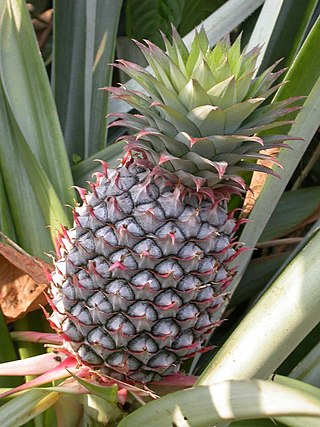
The Bromeliaceae are a family of monocot flowering plants of about 80 genera and 3700 known species, native mainly to the tropical Americas, with several species found in the American subtropics and one in tropical west Africa, Pitcairnia feliciana.

Puya is a genus of the botanical family Bromeliaceae. It is the sole genus of the subfamily Puyoideae, and is composed of 226 species. These terrestrial plants are native to the Andes Mountains of South America and southern Central America. Many of the species are monocarpic, with the parent plant dying after one flower and seed production event.
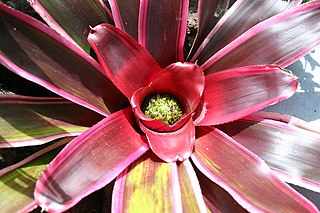
Neoregelia is a genus of epiphytic flowering plants in the family Bromeliaceae, subfamily Bromelioideae, native to South American rainforests. The genus name is for Eduard August von Regel, Director of St. Petersburg Botanic Gardens in Russia (1875–1892).

Araeococcus is a genus of the botanical family Bromeliaceae, subfamily Bromelioideae. It is native to northern South America, Central America and Trinidad.

Cryptanthus is a genus of flowering plants in the family Bromeliaceae, subfamily Bromelioideae. The genus name is from the Greek cryptos (hidden) and anthos (flower). The genus formerly had two recognized subgenera: the type subgenus and subgenus HoplocryptanthusMez which has been raised to the separate genus Hoplocryptanthus. All species of this genus are endemic to Brazil. The common name for any Cryptanthus is "Earth star".

Bromelioideae is a subfamily of the bromeliads (Bromeliaceae). This subfamily is the most diverse in the family, represented by the greatest number of genera with about 40. Most of the plants in this group are epiphytes, though some have evolved in, or will adapt to, terrestrial conditions. This subfamily features the most plant types which are commonly cultivated by people, including the pineapple.
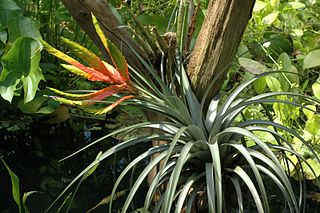
Tillandsioideae is a subfamily of plants in the bromeliad family Bromeliaceae. This subfamily contains the greatest number of species. Most are epiphytic or lithophytic, growing in trees or on rocks where they absorb water and nutrients from the air. Spanish moss of the genus Tillandsia is a well-known species. Bromeliads in the genera Guzmania and Vriesea are the more commonly cultivated members of this subfamily.

Orthophytum is a genus in the plant family Bromeliaceae, subfamily Bromelioideae.
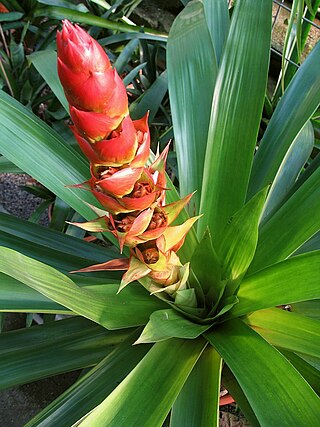
Mezobromelia is a genus of the botanical family Bromeliaceae, subfamily Tillandsioideae. The genus name is for Carl Christian Mez, German botanist (1866-1944). Some authorities treat Mezobromelia as a synonym of Cipuropsis.
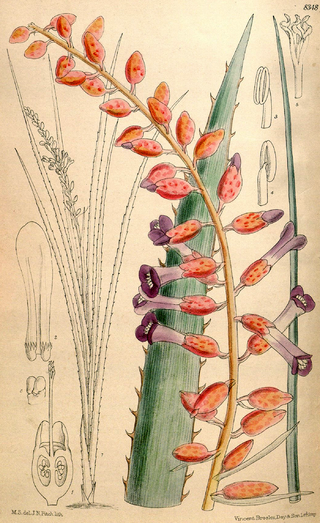
Neoglaziovia is a genus in the plant family Bromeliaceae, subfamily Bromelioideae.

Ronnbergia is a genus in the plant family Bromeliaceae, subfamily Bromelioideae. Native to South and Central America, this genus was named for Auguste Ronnberg, Belgian Director of Agriculture and Horticulture in 1874.
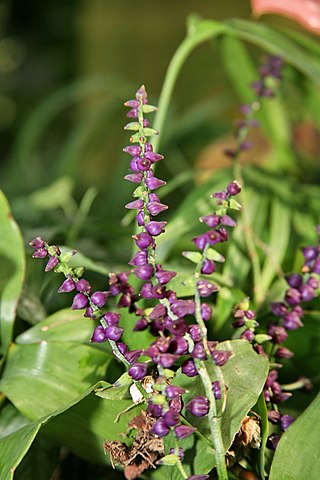
Lymania is a genus in the plant family Bromeliaceae, subfamily Bromelioideae. The genus was established in 1984 to "unite furrowed or winged species from Aechmea subgenera Lamprococcus, Araeococcus and Ronnbergia."

Deinacanthon is a genus of flowering plants in the family Bromeliaceae, subfamily Bromelioideae. The genus name is from the Greek “deinos” - terrible and “anthos” - flower. It contains a single species, Deinacanthon urbanianum, native to Bolivia, Paraguay and Argentina.
Pseudaechmea is a genus of the botanical family Bromeliaceae, subfamily Bromelioideae. The genus name is from the Greek pseudos (false) and the genus Aechmea. The genus was established by Lyman Smith and R.W. Read in 1982. The sole species is Pseudaechmea ambigua, treated as a synonym of Billbergia ambigua by Plants of the World Online as of November 2022.
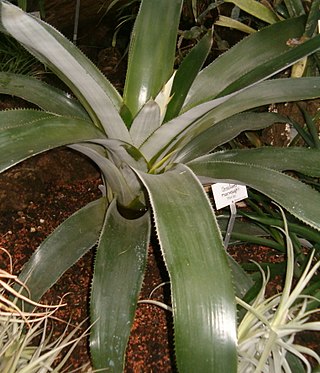
Ursulaea is a genus in the plant family Bromeliaceae, subfamily Bromelioideae. Some authorities treat Ursulaea as a synonym of Aechmea. There are two known species, both endemic to Mexico.
Julian Alfred Steyermark was a Venezuelan American botanist. His focus was on New World vegetation, and he specialized in the family Rubiaceae.
Neoregelia kerryi is a species of flowering plant in the genus Neoregelia. This species is endemic to Brazil. Its name has also been incorrectly spelt Neoregelia kerryae.
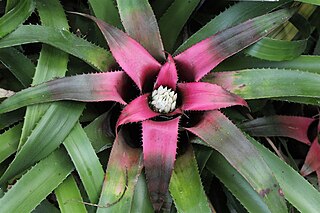
Hylaeaicum is a genus of flowering plant in the family Bromeliaceae, native to tropical northern South America. The taxon was first described by Ernst Heinrich Georg Ule in 1935 as a subgenus of "Aregelia". It was later treated as a subgenus of Neoregelia, before being raised to a full genus in 2021, a status accepted by both Plants of the World Online and the Encyclopaedia of Bromeliads.

Rokautskyia is a genus of flowering plant in the family Bromeliaceae, native to eastern Brazil. The genus was first established in 2017, and is placed in subfamily Bromelioideae.
Elton Martinez Carvalho Leme is a Brazilian who is employed as a judge. He is also a self-taught botanist with a special interest in bromeliads. As of November 2022, the International Plant Names Index listed 629 scientific names which include Leme as a publishing author, including 13 generic names.
















